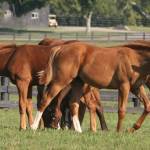Minimize Gastric Ulcers in Rapidly Growing Weanlings

The prevalence of gastric ulcers among Thoroughbreds in training and racing is well known, but gastric ulcers also occur frequently in Thoroughbred foals and yearlings. Reports suggest one-quarter to one-half of foals have gastric ulcers.
“Ulcers compromise the health of the horse, affecting appetite and feed conversion efficiency. In young foals, growth rates can be negatively affected. As many horse owners know, diagnosis with a gastroscope and treatment with omeprazole are expensive, so preventing ulcers is vital,” explained Clarissa Brown-Douglas, Ph.D., a Kentucky Equine Research nutritionist.
In addition to the general stress associated with weaning, the type of feed a foal is offered, such as high-starch concentrate, can also contribute to the development of equine gastric ulcer syndrome (EGUS).
Tradition dictates feeding weanlings high levels of grain-based concentrates (such as oat-, corn-, and barley-based feeds) to achieve the accelerated growth required by Thoroughbred yearlings for sales. However, these high-starch feeds are linked to rapid growth rates and implicated in the manifestation of developmental orthopedic disease, including osteochondritis, angular limb deformities, and physitis.
Considering the potential negative effects of high-starch diets in young, growing horses, there is evidence that the same level of growth can be achieved by feeding a diet in which the energy is provided by fiber as opposed to cereals.
A recent report showed similar growth rates in foals born in the United Kingdom and fed either an all-fiber or a traditional cereal-based creep feed.* In this study, average daily gain, height at the withers and hip, heart girth, and body length were all similar between the groups of weanlings fed either the all-fiber or high-cereal creep feed for 18 weeks. Specifically, the average daily gain was in line with other reported growth rates of Thoroughbreds at the same age.
This study also examined the effect of the two different feeds on stomach pH of the weanlings. Horses fed the all-fiber feed maintained a more consistent and less acidic gastric pH compared with those fed the cereal-based feed. The researchers deduced that the high-fiber ration had the potential to help reduce the incidence of acid-precipitated gastric ulceration.
“This work supports several other studies that have reported a high incidence of gastric ulcers in weanlings, suggesting high-fiber diets protect against gastric ulcers in horses of all ages. Many feed companies are now producing feeds for young, growing horses containing high levels of digestible fiber, including beet pulp and soy hulls, with less reliance on cereal grains,” Brown-Douglas relayed.
In sum, this study adds to the increasing pool of data supporting the use of high-fiber diets to achieve growth rates comparable to traditional cereal-based diets in young horses.
Reducing the risk of the incidence of gastric ulcers in weanlings during their rapid growth can be achieved in one of two ways: by offering a high-fiber feed rather than a traditional cereal-based feed and by supplementing their diets with Triacton, a research-proven supplement developed by Kentucky Equine Research.
Triacton contains a specific source of calcium proven to buffer the gastric and hindgut environments, restoring gastrointestinal normalcy. Triacton features the added benefit of boosting bone mineral density, which is advantageous for growing foals.
*Moore-Colyer, M., P. Tuthill, I. Bannister, and S. Daniels. 2020. Growth rates of Thoroughbred foals and in vitro gut health parameters when fed a cereal or an all-fiber creep feed. Journal of Equine Veterinary Science 93:103191.








